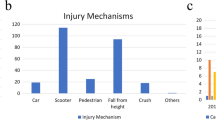Abstract
Purpose
Fractures of the pubic rami due to low energy trauma are common in the elderly, with an incidence of 26 per 100,000 people per year in those aged more than 60 years. The purpose of this study was to evaluate the clinical application of this minimally invasive technique in patients with pubic ramus fractures combined with a sacroiliac joint complex injury, including its feasibility, merits, and limitations.
Methods
Fifteen patients with pubic ramus fractures combined with sacroiliac joint injury were treated with the minimally invasive technique from June 2008 until April 2012. The quality of fracture reduction was evaluated according to the Matta standard.
Results
Fourteen cases were excellent (93.3 %), and one case was good (6.7 %). The fracture lines were healed 12 weeks after the surgery. The 15 patients had follow-up visits between four to 50 months (mean, 22.47 months). All patients returned to their pre-injury jobs and lifestyles. One patient suffered a deep vein thrombosis during the peri-operative period. A filter was placed in the patient before the surgery and was removed six weeks later. There was no thrombus found at the follow-up visits of this patient.
Conclusion
The minimally invasive technique in patients with pubic ramus fractures combined with a sacroiliac joint complex injury provided satisfactory efficacy.



Similar content being viewed by others
References
Hill RM, Robinson CM, Keating JF (2011) Fractures of the pubic rami. Epidemiology and five-year survival. J Bone Joint Surg Br 83(8):1141–1144
Scheyerer MJ, Osterhoff G, Wehrle S, Wanner GA, Simmen HP, Werner CM (2012) Detection of posterior pelvic injuries in fractures of the pubic rami. Injury 43(8):1326–1329
Gao H, Luo CF, Hu CF, Zhang CQ, Zeng BF (2011) Minimally invasive fluoro-navigation screw fixation for the treatment of pelvic ring injuries. Surg Innov 18(3):279–284
Starr AJ, Walter JC, Harris RW, Reinert CM, Jones AL (2002) Percutaneous screw fixation of fractures of the iliac wing and fracture-dislocations of the sacro-iliac joint (OTA types 61-B2.2 and 61-B2.3, or Young-Burgess “lateral compression type II” pelvic fractures). J Orthop Trauma 16(2):116–123
Nicodemo A, Decaroli D, Pallavicini J, Sivieri R, Aprato A, Massè A (2008) A treatment protocol for abdomino-pelvic injuries. J Orthop Traumatol 9(2):89–95
Ghanayem AJ, Wilber JH, Lieberman JM, Motta AO (1995) The effect of laparotomy and external fixator stabilization on pelvic volume in an unstable pelvic injury. J Trauma 38(3):396–400
Matta JM (1996) Indications for anterior fixation of pelvic fractures. Clin Orthop Relat Res 329:88–96
Shuler TE, Boone DC, Gruen GS, Peitzman AB (1995) Percutaneous iliosacral screw fixation: early treatment for unstable posterior pelvic ring disruptions. J Trauma 38(3):453–458
Templeman DC, Simpson T, Matta JM (2005) Surgical management of pelvic ring injuries. Instr Course Lect 54:395–400
Vaidya R, Colen R, Vigdorchik J, Tonnos F, Sethi A (2012) Treatment of unstable pelvic ring injuries with an internal anterior fixator and posterior fixation: initial clinical series. J Orthop Trauma 26(1):1–8
Gökay NS, Bagatur AE (2012) The results of minimally invasive percutaneous plate osteosynthesis (MIPPO) in distal and diaphyseal tibial fractures. Acta Orthop Traumatol Turc 46(4):243–249
Adams JE, Davis GG, Heidepriem RW 3rd, Alonso JE, Alexander CB (2002) Analysis of the incidence of pelvic trauma in fatal automobile accidents. Am J Forensic Med Pathol 23(2):132–136
Gabbe BJ, de Steiger R, Esser M, Bucknill A, Russ MK, Cameron PA (2011) Predictors of mortality following severe pelvic ring fracture: results of a population-based study. Injury 42(10):985–991
Biffl WL, Smith WR, Moore EE, Gonzalez RJ, Morgan SJ, Hennessey T, Offner PJ, Ray CE Jr, Franciose RJ, Burch JM (2001) Evolution of a multidisciplinary clinical pathway for the management of unstable patients with pelvic fractures. Ann Surg 233(6):843–850
Gruen GS, Leit ME, Gruen RJ, Peitzman AB (1994) The acute management of hemodynamically unstable multiple trauma patients with pelvic ring fractures. J Trauma 36(5):706–711
Hiesterman TG, Hill BW, Cole PA (2012) Surgical technique: a percutaneous method of subcutaneous fixation for the anterior pelvic ring: the pelvic bridge. Clin Orthop Relat Res 470(8):2116–2123
Tosounidis T, Kanakaris N, Nikolaou V, Tan B, Giannoudis PV (2012) Assessment of lateral compression type 1 pelvic ring injuries by intraoperative manipulation: which fracture pattern is unstable? Int Orthop 36(12):2553–2558
Kobbe P, Hockertz I, Sellei RM, Reilmann H, Hockertz T (2012) Minimally invasive stabilisation of posterior pelvic-ring instabilities with a transiliac locked compression plate. Int Orthop 36(1):159–164
Karadimas EJ, Nicolson T, Kakagia DD, Matthews SJ, Richards PJ, Giannoudis PV (2011) Angiographic embolisation of pelvic ring injuries. Treatment algorithm and review of the literature. Int Orthop 35(9):1381–1390
Hao T, Changwei Y, Qiulin Z (2009) Treatment of posterior pelvic ring injuries with minimally invasive percutaneous plate osteosynthesis. Int Orthop 33(5):1435–1439
Papakostidis C, Kanakaris NK, Kontakis G, Giannoudis PV (2009) Pelvic ring disruptions: treatment modalities and analysis of outcomes. Int Orthop 33(2):329–338
Conflict of interest
All authors declare that there are no conflicts of interest.
Author information
Authors and Affiliations
Corresponding author
Additional information
Xiaowei Yu and Mingjie Tang contributed equally to this study.
Rights and permissions
About this article
Cite this article
Yu, X., Tang, M., Zhou, Z. et al. Minimally invasive treatment for pubic ramus fractures combined with a sacroiliac joint complex injury. International Orthopaedics (SICOT) 37, 1547–1554 (2013). https://doi.org/10.1007/s00264-013-1954-x
Received:
Accepted:
Published:
Issue Date:
DOI: https://doi.org/10.1007/s00264-013-1954-x




